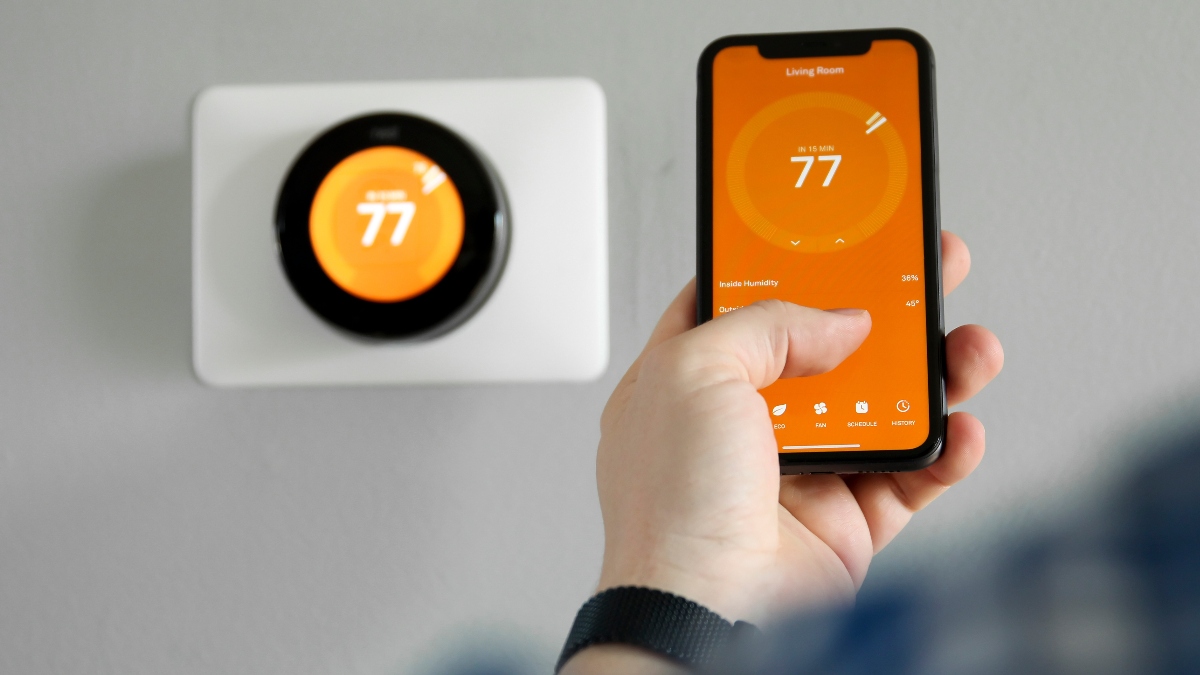During hot summers, it’s not uncommon for a utility bill to skyrocket as your air conditioner tries to keep your home cool. Particularly chilly winters can also mean a huge increase in your heating bill. To help cut down on costs, many people are considering switching over to smart thermostats. Not sure if they’re a right fit for you? Below, you’ll find more information about what a smart thermostat is, if it actually saves you money and what to consider when choosing one.
What is a smart thermostat?
These WiFi-enabled devices, which connect to a home’s heating and cooling system, allow the homeowner the ability to control the temperature remotely via the web or a smartphone app. Many of these thermostats include other features, as well, like voice control or energy tracking.
It’s also common for smart thermostats to learn your temperature preferences and activity, and adjust the settings automatically. This not only keeps things comfortable for you, but can make an impact on energy costs too.
“Smart thermostats achieve energy savings by running the system for the least amount of time possible while still conditioning the living space,” says Gil Canlas, virtual HVAC expert for Frontdoor. “A modern smart thermostat achieves this by tracking when a living space is occupied.”
Do smart thermostats actually save money?
According to many pros, installing a smart thermostat can have some financial perks.
“Though there’s limited data on how much you can save with a smart thermostat, since heating and cooling account for about 55 percent of the total energy used in a typical house, shaving off a few percentages of energy consumption can result in noticeable savings on your heating and cooling bill,” says Angie Hicks, co-founder at Angi. “Some experts estimate that for each degree you raise your thermostat setting, you could save between 1 percent and 3 percent on your energy costs.”
However, several factors generally dictate whether you’ll see a reduction in your energy bill.
These include:
- How often you’re home
- Heating and cooling habits
- How well your home is insulated
- The climate where you live
- The number of people in your home
- Your HVAC equipment
- What features of the thermostat you use
One of the features that can make a lasting impact on your bill are those related to energy-tracking. The ability to check your heating and cooling habits on a regular basis may allow you to make adjustments more regularly.
“Using a smart thermostat can help you be a more conscientious consumer and save money,” says Richie Drew, VP of operations at One Hour Heating & Air Conditioning. “For instance, it can track your system usage and tell you if your habits have changed over time. If you are using your AC or heat more one month, the unit will alert you so you’re not surprised by a higher bill.”
Are smart thermostats worth the investment?
Because of the high price tag associated with many smart thermostats, people often wonder if they’re a useful purchase. For the device to be beneficial, a homeowner needs to be willing to work with the features it offers.
“One of the biggest misconceptions about smart thermostats is that simply installing one will instantly lower your electric bill,” comments Shelley Nytes, manager at Valentine Plumbing and Heating.“While the device can help, the real savings come from how it’s used. If someone installs one but keeps the same temperature settings and habits, they may not see much of a change in energy costs.”
The key is to make sure you program it properly, use vacation or away settings when applicable and have the WiFi set up so it can learn and update as needed.
One thing to keep in mind: If you are having heating or cooling issues in your home, this type of thermostat may not produce the results you want.
“The most important step [before buying] is to ensure that your HVAC system is in good working order,” advises Scott Levene, a licensed HVAC professional and vice president at Levco. “A smart thermostat works best with an efficient system.”
Tips for choosing the best smart thermostat

If you feel you’re ready to purchase a smart thermostat for your home, there are several things to keep in mind when shopping.
Here are some of the key elements you should take into consideration:
- User-friendly design. “Make sure that you’ll be comfortable dealing with the technology, downloading the app, troubleshooting WiFi issues, and more,” says Hicks.
- ENERGY STAR-certification. This means it uses less energy than standard models.
- Compatibility with your HVAC system. “Some older systems or multi-zone setups may need a specific model,” shares Nytes.
- Features that fit with your lifestyle. This could be voice control, mobile app access, etc.
- Ease of installation. In some cases, you may want to consider “professional installation to avoid tricky wiring and damage to your system,” says Drew.
- Placement on your wall. “Will the new thermostat be able to fit in its old mounting spot or are there other controls around it blocking it from being mounted to the wall?” comments Canlas. “Will it cover unfinished paint behind the old thermostat?”
To help cut down on costs of the thermostat, look for deals (like Amazon smart thermostats that are on sale during this Prime Day, which runs until 11.59 p.m. on July 11, 2025) or even by contacting your utility provider.
“Many offer rebates that reduce the upfront cost,” shares Nytes.






